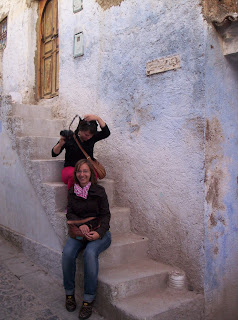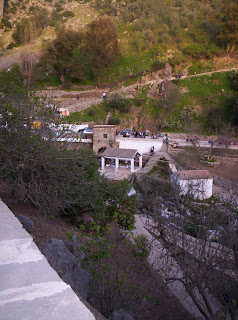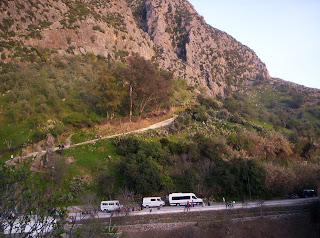The second half of my Spring Break was far less interesting, exploit-wise, than the first half. Suffice it to say that beach chair rental was only 20 dhs for the whole day.
The next morning our professors took us on another walk through town, ending at the Kasbah.[5]
Besides, I’ve been meaning to catch you up on more recent events. For instance, two weekends ago AMIDEAST took us all on an official excursion to Tangier and Chefchaoen.
As some of you may remember, I’ve been to Tangier before, having traveled there with some friends on one of the first weekends of the semester. I was excited to go back, since it remains one of my favorite cities in Morocco. Luckily for you, this time I had a functional camera.
We stopped for lunch at the Caves of Hercules, in which the mythical hero once allegedly slept. Morocco is supposed to be the setting of Hercules’ famous labors, so he pops up in lots of local folklore. For instance, he is supposed to have created the Strait of Gibraltar by pushing Europe and Africa apart with his bare hands. Unfortunately my camera was under the bus at this point, but the famous Africa-shaped hole which is the caves’ main attraction has been more than sufficiently documented without my help. As you might expect, the caves are quite the tourist trap. In any case, it was a lovely spot to eat lunch overlooking the sea.
After checking into our hotel in Tangier and having a few hours of free time (during which I napped, having gotten up much earlier than I’d have liked in order to make the bus on time) we headed en masse to the American Legation Museum. The American Legation in Tangier is the only United States Historic Landmark
which is located in a foreign country. It has been U.S. property since the early 19th century[1]. It has served a variety of purposes over the years, including as a Peace Corps training site, but now is primarily a museum and research center.[2] There are some lovely portraits and an entire room dedicated to Paul Bowles and the other members of the Beat Generation who made Tangier their home in the fifties and sixties. The real star, though, is the building itself, which is really lovely and a fascinating mix of Moroccan and American.
which is located in a foreign country. It has been U.S. property since the early 19th century[1]. It has served a variety of purposes over the years, including as a Peace Corps training site, but now is primarily a museum and research center.[2] There are some lovely portraits and an entire room dedicated to Paul Bowles and the other members of the Beat Generation who made Tangier their home in the fifties and sixties. The real star, though, is the building itself, which is really lovely and a fascinating mix of Moroccan and American.
The next morning my friends and I wandered up into the Kasbah to look at the view towards Spain. Unfortunately, the weather wasn’t quite as clear this time as it had been on my first visit, so we couldn’t see all the way to the Iberian coast. It was still definitely worth the trek, though.
After lunch, we climbed back into the bus and headed for the small but gorgeous mountain city of Chefchaoen.[3] The winding and sometimes death-defying route to Chaoen was a little harrowing, but well worth it. The town is known for its white and blue houses[4], and is often used as a sort of base camp for hiking in the Rif Mountains. After a pleasant and leisurely stroll through the medina, a group of us hiked up to the mosque overlooking the town.
[1] Morocco was the first foreign nation to recognize U.S. sovereignty. The Legation and the land on which it is located were a gift from the Sultan to commemorate this special relationship.
[2] Graduate students from the US and from other Maghreb nations can apply to do social science research projects at the center. Out came my career advancement antennae.
[3] In a very Moroccan mixture of Amazigh and Arabic, Chefchaoen’s name means “look at the peaks,” or, alternatively, “look at the horns.”
[4] This may have something to do with repelling mosquitoes, reducing glare, the town’s formerly significant Jewish population, or some combination of these.
[5] Fortress. Sort of like the burgh or keep in a medieval European city.






































































